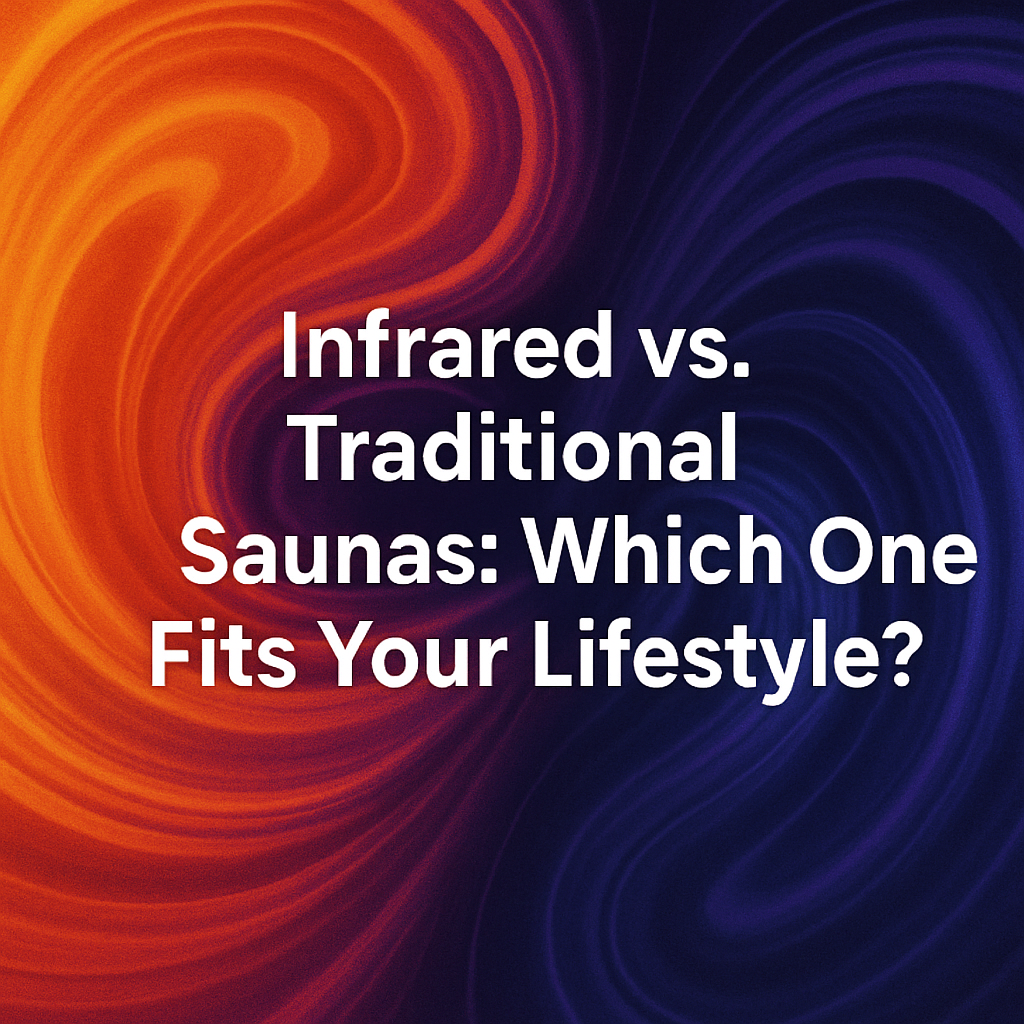
Infrared Sauna Types: Full‑Spectrum vs Near vs Far Infrared Guide
Modern infrared saunas offer more than just a gentle, sweat‑inducing heat. They come in several different wavelengths—near infrared (NIR), mid infrared (MIR) and far infrared (FIR)—each with its own physiological effects. There is also the full‑spectrum infrared sauna, which combines all three wavelengths for a broad range of benefits. Whether you’re a wellness enthusiast looking to upgrade your home spa or a newcomer exploring sauna options, understanding these differences will help you choose the right sauna for your goals and space.
🔍 Quick Answers to Common Questions
What is the difference between near, mid and far infrared? Infrared light sits just beyond visible red light on the electromagnetic spectrum. Near infrared (NIR) has the shortest wavelength and primarily penetrates the skin, supporting inflammation reduction and collagen production. Mid infrared (MIR) penetrates deeper into muscles and connective tissue, expanding blood vessels and increasing local circulation. Far infrared (FIR) has the longest wavelength, penetrating the body most deeply to boost metabolic rate, cellular oxygenation and recovery.
What is a full‑spectrum infrared sauna? A full‑spectrum sauna emits all three wavelengths (near, mid and far infrared). Full‑spectrum systems provide the combined benefits of all wavelengths, such as increased circulation, improved cellular oxygenation, better temperature regulation and enhanced sleep. In sauna form, this means you can enjoy skin‑healing NIR light, muscle‑targeting MIR heat and deep‑detoxifying FIR in one session.
How do infrared saunas differ from traditional saunas? Traditional saunas heat the air around you using wood, gas or electric heaters, raising the ambient temperature as high as 195 °F. In contrast, infrared saunas warm your body directly using light, allowing lower air temperatures (100–150 °F). This makes infrared saunas more comfortable for people sensitive to high heat while still inducing a profuse sweat for detoxification.
Do infrared saunas have the same health benefits as traditional saunas? Both traditional and infrared saunas offer benefits such as improved circulation, cardiovascular conditioning, stress reduction and immune support. Infrared saunas may provide additional skin health, wound healing and deep‑tissue pain relief because their wavelengths penetrate deeper and are associated with increased collagen production and improved blood flow.
How often should you use an infrared sauna? For general wellness, two to four sessions per week lasting 15–30 minutes are typically recommended. Start with shorter sessions to gauge your tolerance, hydrate well and allow time to cool down between sessions.
📡 Understanding Infrared: Near, Mid and Far
Infrared energy is divided into three categories: near, mid and far. The wavelength determines how deeply the energy penetrates and which tissues it affects.
👧 Near Infrared (NIR)
NIR light is closest to the visible spectrum and penetrates the outer layers of the skin. It is widely used for skin‑health applications, including LED therapy and photo biomodulation. NIR helps reduce inflammation, increase collagen production and stimulate tissue healing. It can also enhance mitochondrial function, leading to greater cellular energy and improved healing after injuries.
Benefits
-
Enhanced skin health: Stimulates collagen production and improves skin elasticity, helping reduce wrinkles and improving tone.
-
Wound healing and tissue repair: Accelerates healing of cuts and abrasions.
-
Increased cellular energy: Supports mitochondrial function, which enhances recovery and overall wellness.
-
Improved circulation: Increases blood flow to superficial tissues, reducing inflammation and soreness.
Drawbacks
Because NIR primarily affects surface tissues, it doesn’t induce as intense a sweat or as deep a detoxification effect as FIR. For people focused on deep tissue detox or intense muscle recovery, NIR alone may not suffice.
💪 Mid Infrared (MIR)
MIR penetrates more deeply than NIR, reaching muscles and connective tissues. Although MIR saunas are less common, full‑spectrum models include this wavelength.
Benefits
-
Expanded blood vessels: MIR helps dilate blood vessels and increase circulation, delivering oxygen and nutrients to deeper tissues.
-
Muscle recovery: By warming muscles and connective tissues, MIR supports recovery after exercise and may relieve chronic pain.
-
Joint flexibility: The deeper warmth can help reduce stiffness and improve range of motion.
Drawbacks
MIR saunas may require longer heating times or higher power to reach effective levels. They are also less widely available as standalone units but are integrated into full‑spectrum models.
🔥 Far Infrared (FIR)
FIR has the longest wavelength, allowing it to penetrate deepest into soft tissue and even influence metabolic and cellular processes. FIR is the most common type of infrared used in saunas.
Benefits
-
Deep detoxification: FIR induces intense sweating to help eliminate toxins, heavy metals and chemicals.
-
Pain and joint relief: The deep heat alleviates muscle tension, joint stiffness and chronic pain.
-
Enhanced cardiovascular health: FIR elevates heart rate and circulation, mimicking moderate exercise and supporting cardiovascular conditioning.
-
Stress reduction: The deep warmth activates the parasympathetic nervous system, promoting relaxation and lowering cortisol levels.
-
Weight management support: FIR sessions can raise metabolism and help burn additional calories, though this should complement a healthy diet and regular exercise.
Drawbacks
FIR saunas can feel hotter than NIR or MIR, especially for first‑time users. Because they generate more intense sweat, you must hydrate well and avoid overexposure. FIR also tends to heat up more slowly than NIR devices.
🌈 Full Spectrum Infrared: The Best of All Worlds
A full‑spectrum infrared sauna combines NIR, MIR and FIR wavelengths, delivering a comprehensive wellness experience. By harnessing all three wavelengths, full‑spectrum saunas provide benefits across skin, muscles and deeper tissues.
Why choose full spectrum?
-
Comprehensive health benefits: You receive skin rejuvenation from NIR, increased circulation from MIR, and deep detox and recovery from FIR—simultaneously or in sequence.
-
Adaptable sessions: Full‑spectrum saunas often allow you to adjust which wavelengths are active, tailoring your session for skin care, muscle recovery or detox.
-
Improved sleep and energy: Full‑spectrum infrared improves circulation, cellular oxygenation, temperature regulation and sleep quality.
-
More comfortable heat: Because full‑spectrum saunas use infrared rather than hot air, you can sweat profusely without the suffocating heat of traditional saunas.
Considerations
-
Cost: Full‑spectrum models tend to be more expensive due to additional heaters and controls.
-
Power requirements: You may need extra circuits to power multiple wavelength emitters, especially in larger units.
-
Space: Full‑spectrum saunas come in various sizes, but you’ll need enough room for the cabin, ventilation and electrical wiring.
🛠️ Choosing the Right Infrared Sauna for Your Needs
When deciding between NIR, FIR or full‑spectrum saunas, consider your wellness priorities:
-
Skin health & light therapy: Choose a near infrared or full‑spectrum sauna. NIR boosts collagen production and wound healing.
-
Muscle recovery & circulation: Choose mid or full spectrum for deeper tissue penetration and improved blood flow.
-
Deep detox & weight management: Opt for far infrared or full spectrum to induce intense sweating and boost metabolism.
-
Comprehensive benefits & flexibility: Select full spectrum for all‑around wellness and the ability to customize sessions.
🧖♀️ Build Your Infrared Sauna Ritual
To maximize the benefits of any infrared sauna, create a consistent ritual:
-
Hydrate & prepare: Drink water or an electrolyte beverage before each session. Have a towel and timer ready.
-
Set the mode: For full‑spectrum saunas, select the wavelength combination that matches your goals. If using an FIR or NIR sauna, adjust temperature accordingly.
-
Session length: Start with 10–15 minutes. Gradually increase to 20–30 minutes as your body adapts. Listen to your body; exit if you feel dizzy or overheated.
-
Breathwork & mindfulness: Use the quiet time for deep breathing, meditation or gentle stretching to enhance relaxation.
-
Cool down: Step out and rest in a cool room or take a lukewarm shower. Hydrate again and allow your heart rate and body temperature to return to normal.
-
Repeat: Enjoy 2–4 sessions per week for sustained benefits. Consistency is key.
🛍️ Accessories for a Customizable Infrared Session
| Accessory | Purpose | Notes & Benefits |
|---|---|---|
| Adjustable infrared control panel | Allows you to switch between NIR, MIR and FIR modes | Essential for full‑spectrum saunas; customize your session for skin care, muscle recovery or detox |
| Infrared‑safe backrest & bench cushion | Provides comfort and support during longer sessions | Choose moisture‑resistant materials like cedar or bamboo to endure heat and sweat |
| Chromotherapy lights | Adds cultured light therapy to complement infrared wavelengths | Colors like blue and purple enhance relaxation; red and amber promote energy |
| Aromatherapy diffuser | Infuses the air with essential oils for relaxation and respiratory benefits | Lavender for calm, eucalyptus for clear breathing |
| Heart‑rate monitor & thermometer | Tracks your physiological response and room temperature | Helps you stay within safe heat zones and evaluate session intensity |
🗣️ Voice‑Optimized FAQ
Are full‑spectrum infrared saunas more effective than far infrared alone? Full‑spectrum saunas offer a broader range of benefits by combining NIR, MIR and FIR. FIR delivers deep detox and cardiovascular conditioning, while NIR and MIR support skin and muscle health. If you want versatility, full spectrum is often the superior choice. However, FIR saunas remain excellent for detox and circulation.
What makes mid infrared different from near and far infrared? Mid infrared has a wavelength between NIR and FIR, allowing it to penetrate deeper than NIR but not as deep as FIR. MIR primarily expands blood vessels and increases circulation, making it useful for muscle recovery and reducing inflammation.
Can I retrofit my existing infrared sauna to full spectrum? Some manufacturers offer upgrade kits that add NIR or MIR panels to FIR saunas. Always consult a licensed electrician to ensure your sauna can handle additional electrical load and that the install is safe.
Are infrared saunas safe for everyone? Infrared saunas are generally safe for healthy adults. However, pregnant individuals, those with cardiovascular conditions, and people taking medications that impair sweating should consult a healthcare professional before use. Always stay hydrated and listen to your body.
How much space and power do full‑spectrum saunas require? A one‑person infrared sauna typically requires a dedicated 15‑amp circuit and about 4–5 square feet of floor space. Larger units may need a 20‑ or 30‑amp circuit and more room. Check the manufacturer’s specifications before installation.
💬 Conclusion & Call to Action
Infrared saunas represent a modern evolution of heat therapy, offering targeted wavelengths for skin health, muscle recovery and deep detoxification. Near infrared supports collagen production and wound healing, mid infrared expands blood vessels for improved circulation, and far infrared penetrates deepest for metabolic benefits, pain relief and weight support. Full‑spectrum infrared saunas combine all three, giving you the freedom to customize your wellness experience and enjoy comprehensive benefits.
Ready to harness the power of infrared light? At saunaluxuries.com, we offer a curated selection of far‑infrared, near‑infrared and full‑spectrum saunas, along with accessories to tailor your sessions. Whether you’re seeking skincare benefits, muscle recovery or total detox, our experts can help you choose the perfect infrared sauna for your home. Embrace the healing heat and elevate your wellness today!







Leave a comment
This site is protected by hCaptcha and the hCaptcha Privacy Policy and Terms of Service apply.